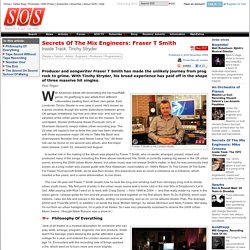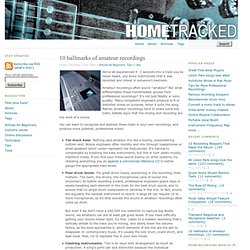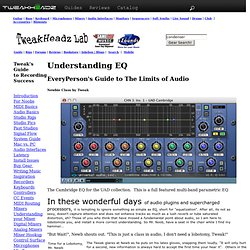

Jimmy Jam & Terry Lewis In Studio w/ Donnie Simpson. Glennbach.com - StumbleUpon. Untitled. Producer and songwriter Fraser T Smith has made the unlikely journey from prog rock to grime.

With Tinchy Stryder, his broad experience has paid off in the shape of three massive hit singles. Paul Tingen Fraser T Smith in his London studio. With American artists still dominating the hip‑hop/R&B genre, it's gratifying to see artists from different nationalities beating them at their own game. East Londoner Tinchy Stryder is one case in point. A central role in the making of the album was played by Fraser T Smith, who co‑wrote, arranged, played, mixed and produced many of the songs, including the three above‑mentioned hits. The now 38‑year‑old Fraser T Smith recalls how he took the long and winding road from old‑hippy prog rock to trendy urban youth music. Philosophy Of Everything Smith's MyAudioTonic Studio is based around Pro Tools, but with a 32‑channel Chandler summing mixer and a healthy selection of outboard. "But my setup here at the moment really works for me. 'Number One' The End.
Alan Moulder's 'Secret Squirrel' The Big Trees - Alan Moulder and Flood. 50 Mixing Tips From Steven Slate. The 27 best free VST plug-ins in the world today. 10 hallmarks of amateur recordings - Hometracked. We’ve all experienced it: 3 seconds into a track you’ve never heard, you know instinctively that it was recorded and mixed in someone’s bedroom.

Amateur recordings often sound “amateur.” But what differentiates these hometracked opuses from professional recordings? It’s not just fidelity or sonic quality: Many competent engineers produce lo-fi or distorted mixes on purpose, when it suits the song. Rather, amateur recordings tend to share some key traits, telltale signs that the mixing and recording are the work of a novice. You can learn to recognize and address these traits in your own recordings, and produce more polished, professional mixes: Too much bass: Nothing says amateur mix like a boomy, overpowering bottom-end.
See Also: 5 Ways To Improve Your Recordings Today, Record Better Vocals. EQ and the Limits of Audio by TweakHeadz Lab. EveryPerson's Guide to The Limits of Audio Newbie Class by Tweak The Cambridge EQ for the UAD collection.

This is a full featured multi-band parametric EQ In these wonderful days of audio plugins and supercharged processors,it is tempting to ignore something as simple as EQ, short for "equalization". After all, its not as sexy, doesn't capture attention and does not enhance tracks as much as a lush reverb or tube saturated distortion, eh?
"But Wait! " The Tweak glares at Newb as he puts on his latex gloves, snapping them loudly. "Class, should I do it? " "No Tweak you might kill him! " Tweak drops the hammer, sends Newb to his seat and resumes his tweakly demeanor. Handy EQ Reference. EQ Drums. One of the things I love most about recording music is that there are no rules.

One guy decides to use a cardboard box as his kick drum sound…and it sounds awesome. Another guy decides to sample in the sound of a screaming cat and blend it with the cymbals. (Okay, I’ve never seen that, but I bet it’s awesome.) You’re free to do whatever you want. Maybe that’s why so many people record music as a hobby. But there is one “rule” I almost always follow when mixing drums…and it almost always works. It’s really simple. I’ve heard it over and over again from mix engineers.
It’s hard to explain. This is all without boosting the lows or the highs. You’ve got a set budget for the month. You’ve got a set number of frequencies to work with. You decide you want to spend an extra $200 on a piece of gear. You decide you need more low end in your kick drum. You take $200 out of ANOTHER part of the budget to pay for the gear. You cut 400 Hz to bring out the low end down at 80 Hz. How Can I Set Up a Home Recording Studio on the Cheap? Also, keep in mind that not everyone needs an audio interface. if you are only recording one track at a time or are recording more than one track but are fine with mixing it as you record you can use a much cheaper and oodles simpler analog mixing board/mixer. i struggled for over a year with a USB audio interface box i bought for home recording and it was ALWAYS a hassle - either really high latency, dropped sections, or it would take 15-20 minutes of fiddling with system prefs and settings in software to get it to work right. i finally went to my local music store and picked up a behringer analog mixer for $49 which has 8-Inputs (2 mic, 2 stereo, 1 stereo tape/CD), builtin EQ, effects send/receive, and the mic jacks have phantom power and the line inputs work great for electric instruments, a headphone out and I use an RCA-to-mini-1/8th-stereo plug to connect directly into the mic jack on my mac mini.
